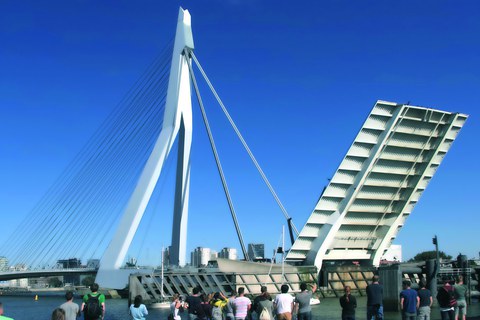Rhine and Netherlands
Bridges in "Rhine Culture" and Bridges in Motion

Erasmus Bridge in Rotterdam
Every year, the Institute of Solid Construction organizes the bridge excursion. The excursion is primarily aimed at students in the 6th and 8th semesters and thus offers the opportunity to view the theoretically acquired basics in situ. This year, 22 students followed the call to the Netherlands. In addition to interesting bridge structures, they also visited civil engineering construction sites during an entire week. In line with the motto "Bridges in Rhine Culture", the first destination of the excursion was the Schiersteiner Kreuz freeway bridge over the Rhine. After a detailed explanation of the construction process, insights into the box girder construction were provided. Against the flow direction of the Moselle, the next day the students went to the currently largest bridge construction site in Europe, the Hochmosel crossing. There, the students were given impressive insights into the construction process and the feed of the steel superstructure at the construction site. Furthermore, the special features of the construction of the pier and superstructure were explained, which result from the exposed location and the associated local winds. Afterwards, the side of the Rhine was changed. The route led along the Lahn to Limburg. The destination was on the one hand the new construction of the Lahntal bridge, a bridge in prestressed concrete (the nowadays common mixed construction method), on the other hand the demolition work of the old Lahntal bridge could be viewed using an adapted feed scaffold.
The next day, the focus was first on the city of Cologne. After visiting the first real suspension bridge in Germany, the Cologne-Rodenkirchen bridge, including a tour of the anchor chambers and climbing the 60 m high pylon, the students were able to explore the city of Cologne and its sights on their own. The afternoon continued via Eindhoven with a stopover at the "Hovenring" bicycle bridge to Rotterdam. Here, a visit to the Erasmus Bridge and the Rijnhaven Bridge was a must in order to do justice to the second motto "Bridges in motion". Before that, they visited the space truss bridge "Green Link" in Rotterdam. In the afternoon, the students were given an insight into projects and the everyday office life of Ipv-Delft, an engineering office of a special kind. In addition to architects and civil engineers, product designers also work here, which ultimately led to a large number of innovative bridge concepts, especially for pedestrian and bicycle bridges. Here we were given details of the Hovenring, which we had visited the day before, before being given a guided tour of the Delft train station construction site. On the way to Amsterdam in the evening, the excursion participants stopped in Hoofdoorp to admire interesting bridges designed by the star architect Calatrava.
Arriving in Amsterdam, the first stop was underground. Following the tunnel construction site, the Spaarndammertunnel, a tunnel construction site using the cut-and-cover method, there was a visit to another special underground construction site. The Boerenweteringgarage is the first underground car park to be built underneath a canal. The special challenges of construction in an urban area in conjunction with a demanding subsoil were very clearly demonstrated by these structures. In the afternoon, we visited the Nesciobrug, one of the largest pedestrian bridges in the Netherlands. The next day, by now a weekend day, began in the calm waters of Amsterdam's canals with a boat trip. In addition to the numerous small movable bridges and many masonry bridges, this also provided a new perspective. After the excursion to the Netherlands, we returned to Germany, to the Ruhr area, on Saturday evening.
On the way back to Germany, two bridges in Nijmegen, De Oversteek and de Groentje Brug, were on the agenda. On Sunday, the motto "bridges in motion" came to the fore again. In contrast to the movable bridges in the Netherlands, the focus was now on movement as a result of vibration. The numerous filigree pedestrian bridges in the Ruhr area are particularly suitable for "load tests" by prospective bridge engineers. After starting in Duisburg, with the roller coaster-like bridge "Tiger and Turtle" and the movable suspension bridge in the inner harbor, the tour continued to Oberhausen. Here, too, the Rehberger Bridge and the Ripshorster Steg were able to withstand the load tests. The dynamic test day was concluded in Gelsenkirchen. The double arch in Nordsternpark could also be visited, as could the circular ring girder bridge "Grimberger Sichel". Finally, a visit to the Zollverein coal mine in Essen was a must during a visit to the Ruhr area.
Before the trip led back to Dresden, the expansion of the BAB 45 and the B480n feeder road were presented. Three large viaducts were built here, two of which, the Nuttlar viaduct and the Bermecke viaduct, were explained in more detail to the excursion participants on site. The excursion was rounded off by a visit to a timber construction company where glulam girders with a span of up to ≈ 50 m were manufactured. All in all, this resulted in a varied program in which the wide range of civil engineering could be demonstrated.
Dipl.-Ing. Oliver Steinbock and Dipl.-Ing. Jakob Bochmann
